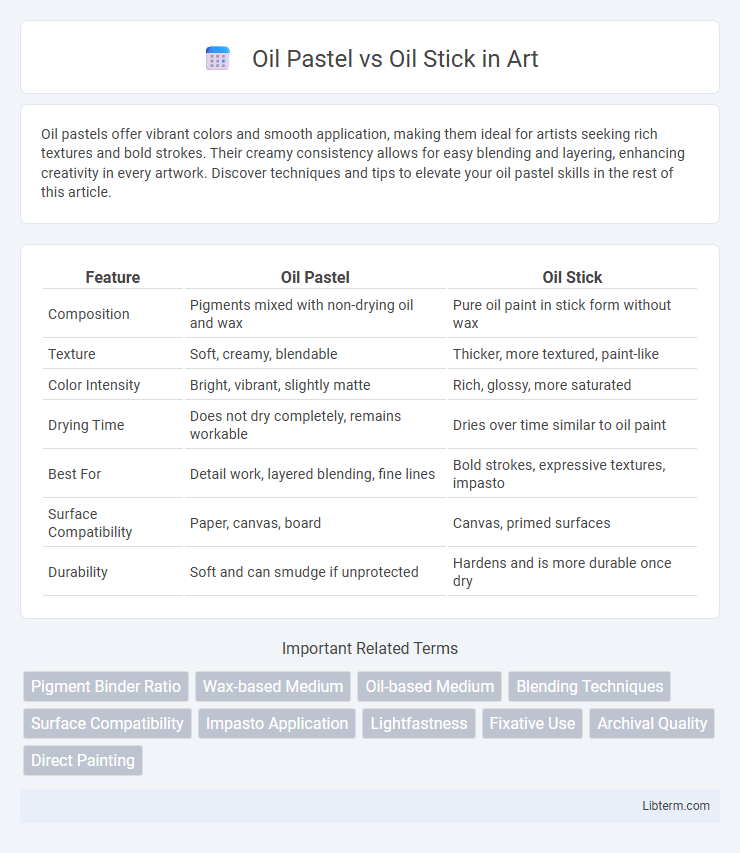Oil pastels offer vibrant colors and smooth application, making them ideal for artists seeking rich textures and bold strokes. Their creamy consistency allows for easy blending and layering, enhancing creativity in every artwork. Discover techniques and tips to elevate your oil pastel skills in the rest of this article.
Table of Comparison
| Feature | Oil Pastel | Oil Stick |
|---|---|---|
| Composition | Pigments mixed with non-drying oil and wax | Pure oil paint in stick form without wax |
| Texture | Soft, creamy, blendable | Thicker, more textured, paint-like |
| Color Intensity | Bright, vibrant, slightly matte | Rich, glossy, more saturated |
| Drying Time | Does not dry completely, remains workable | Dries over time similar to oil paint |
| Best For | Detail work, layered blending, fine lines | Bold strokes, expressive textures, impasto |
| Surface Compatibility | Paper, canvas, board | Canvas, primed surfaces |
| Durability | Soft and can smudge if unprotected | Hardens and is more durable once dry |
Introduction to Oil Pastels and Oil Sticks
Oil pastels consist of pigment mixed with a non-drying oil and wax binder, offering vibrant colors and a soft, blendable texture ideal for detailed artwork and layering techniques. Oil sticks, composed of oil paint bound in a solid, crayon-like form, deliver rich, buttery consistency with intense pigment and are favored for expressive, textured strokes in fine art and plein air painting. Both mediums provide unique tactile experiences, with oil pastels suited for precision and smooth blending, while oil sticks emphasize bold, painterly effects.
Composition and Material Differences
Oil pastels consist of a non-drying, waxy binder mixed with pigment, offering a soft, blendable texture suitable for layering and smudging. Oil sticks contain a higher concentration of oil and pigment combined with wax, creating a denser, stick-like form that mimics the consistency of oil paint and provides more intense, saturated colors. The key material difference lies in oil pastels' softer, pliable composition versus oil sticks' firmer, paint-like consistency, affecting their handling and finish.
Texture and Application Techniques
Oil pastels offer a creamy, smooth texture that blends easily on paper, allowing for soft gradients and detailed layering through gentle pressure and finger smudging. Oil sticks, with their solid, stick-like form, provide a richer, more concentrated application that produces bold, textured strokes ideal for expressive, painterly effects on canvas or heavy paper. Both mediums support versatile techniques, but oil pastels excel in fine blending and subtle transitions, while oil sticks favor dynamic, impasto textures and vigorous mark-making.
Color Vibrancy and Coverage
Oil pastels deliver rich, vibrant colors due to their high pigment concentration and smooth texture, allowing for intense color saturation. Oil sticks, made with a waxier base and thicker consistency, provide more opaque coverage and a bolder application, ideal for creating strong, saturated layers. Both mediums excel in color vibrancy, but oil sticks offer superior coverage and a more painterly effect compared to the softer, blendable quality of oil pastels.
Blending and Layering Capabilities
Oil pastels offer smooth blending with a creamy texture that allows artists to create soft gradients and rich color transitions using fingers or blending tools. Oil sticks provide stronger layering capabilities due to their firmer consistency, enabling artists to build bold, textured strokes and vibrant overlays without smudging. Both mediums excel in blending and layering, but oil pastels are ideal for subtle color mixing, while oil sticks cater to expressive, tactile applications.
Surface Compatibility
Oil pastels provide excellent surface compatibility, adhering well to textured papers, canvas, and wood, allowing artists to achieve vibrant colors on rough or smooth mediums. Oil sticks, composed of oil paint in stick form, perform best on primed or non-porous surfaces like canvas and prepared boards, ensuring smooth application and rich color blending. Both mediums require surface preparation for optimal performance, but oil pastels offer more versatility across diverse textures.
Drying Time and Fixatives
Oil pastels have a slower drying time as the pigment remains in a semi-wet, malleable state, allowing for blending and layering but requiring fixatives like workable fixative sprays to prevent smudging. Oil sticks, composed of oil paint in stick form, dry faster than oil pastels due to their oil content and binders, often requiring a longer curing period but less need for fixatives. Both mediums benefit from using fixatives or varnishes to preserve artwork and prevent smearing, with oil sticks generally having stronger adherence once dried.
Suitability for Different Art Styles
Oil pastels offer vibrant, blendable colors ideal for detailed, precise work and mixed-media techniques, making them suitable for impressionistic and contemporary styles. Oil sticks provide a bolder, more expressive mark with a texture similar to oil paint, favoring gestural, abstract, and impasto techniques. Artists seeking fine control and layering benefit from oil pastels, while those exploring dynamic, textured brushstrokes gravitate toward oil sticks.
Cost and Accessibility
Oil pastels typically offer a lower cost and greater accessibility, making them ideal for beginners and hobbyists seeking affordable, easy-to-use materials available in most art supply stores. Oil sticks, while pricier due to their higher pigment concentration and artist-grade quality, are favored by professionals for their rich texture and versatility but may require specialty retailers or online purchases. The choice between oil pastels and oil sticks often balances budget constraints against desired artistic effects and availability of materials.
Choosing the Right Medium for Your Art
Choosing between oil pastels and oil sticks depends on your desired texture and application technique; oil pastels offer a softer, blendable consistency ideal for detailed work, while oil sticks provide a richer, more painterly effect suited to expressive, bold strokes. Both mediums are oil-based and deliver vibrant, long-lasting colors, but oil sticks are easier to use for direct drawing and layering on canvas, mimicking traditional oil painting methods. Consider the surface and drying time as oil sticks take longer to dry, requiring proper ventilation and finishing techniques to ensure durability.
Oil Pastel Infographic

 libterm.com
libterm.com